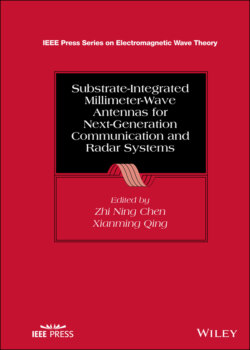Читать книгу Substrate-Integrated Millimeter-Wave Antennas for Next-Generation Communication and Radar Systems - Группа авторов - Страница 19
1.3.2.1 Next‐Generation Wireless Communications
ОглавлениеWireless communications are rapidly progressing toward high data‐rate and ultra‐low latency for the Internet of Things (IoT). Due to the requirement to support higher data‐rate, mmW technology is promising for 5G networks over the frequency range from 24 to 86 GHz. Investment on the research and technology development of mmW cellular mobile networks and WLAN/WiFi infrastructures is increasing exponentially. For instance, mmW technology is the main candidate for the concept of small cells for future cellular network implementation. The mmW technology can be used not only for mobile terminals but also for point‐to‐point backhauls, to some degree to replace traditional fiber optic transmission lines by connecting mobile base stations (BSs).
Table 1.3 Selected key milestones of research and development of mmW technology by 1980s.
| Period | Important activities | Typical applications | Selected references |
|---|---|---|---|
| 1890–1945 | Hertz and Lebedew's experiments in centimeter / millimeter wavelengthNichols, Tear, and Glagolewa‐Arkadiewa developed instruments extended to 0.22 and 0.082 mm using spark‐gap generatorCleeton and William developed vacuum tube sourcesBoot and Randall developed cavity magnetron for radar | Confirmed Maxwell's predictionRadiometermmW sources10 and 24‐GHz radar | [5–10] |
| 1947–1965 | Atmospheric attenuation measurement by Beringer, Van Vleck's and GordyAll circular‐electric mode transmission with all RF components by Bell LabsGeodesic lens antenna by Georgia Technology58‐GHz broad‐brand helix traveling‐wave amplifiers by Bell Labs150‐GHz backward‐wave oscillators by Thomson‐CSF, FranceImaging line, its associated components and surface‐wave propagation on Goubau line or Sommerfeld wave on uncoated metal wire by WiltseFirst IRE Millimeter and Sub‐millimeter Conference held in Orlando, FL, USA in 1963First special issue of The IEEE Proceedings published in April 1966 | Point‐to‐point transmissionThe first 14‐km long transmission systemSpectroscopy70‐GHz radarmmW sourcesHigh‐power mmW sources | [11–17] |
| 1965–1984 | Development of components at 35, 94, 140, and 220‐GHz by US Army Ballistic Research Laboratory as well as Royal Radar Establishment, UKThe first special issue of the IEEE Transaction on Antennas and Propagation about millimeter wave antennas and propagation.Solid state source | RadiometersRadarsMissile guidanceCommunications | More details can be found at [18–20] |
Figure 1.3 Slot antennas.
